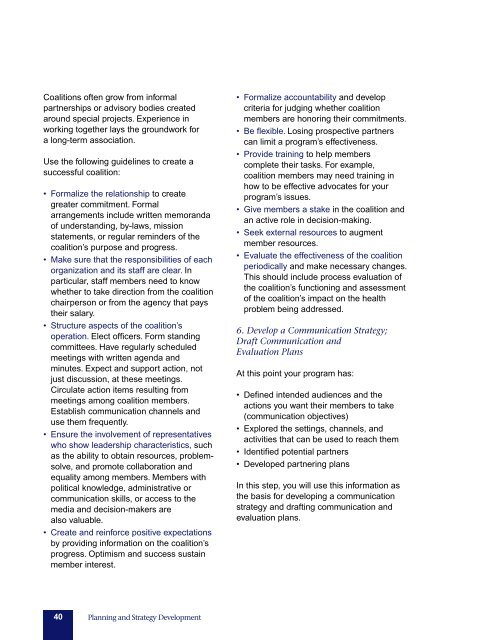pink-book
pink-book
pink-book
You also want an ePaper? Increase the reach of your titles
YUMPU automatically turns print PDFs into web optimized ePapers that Google loves.
Coalitions often grow from informal<br />
partnerships or advisory bodies created<br />
around special projects. Experience in<br />
working together lays the groundwork for<br />
a long-term association.<br />
Use the following guidelines to create a<br />
successful coalition:<br />
• Formalize the relationship to create<br />
greater commitment. Formal<br />
arrangements include written memoranda<br />
of understanding, by-laws, mission<br />
statements, or regular reminders of the<br />
coalition’s purpose and progress.<br />
• Make sure that the responsibilities of each<br />
organization and its staff are clear. In<br />
particular, staff members need to know<br />
whether to take direction from the coalition<br />
chairperson or from the agency that pays<br />
their salary.<br />
• Structure aspects of the coalition’s<br />
operation. Elect officers. Form standing<br />
committees. Have regularly scheduled<br />
meetings with written agenda and<br />
minutes. Expect and support action, not<br />
just discussion, at these meetings.<br />
Circulate action items resulting from<br />
meetings among coalition members.<br />
Establish communication channels and<br />
use them frequently.<br />
• Ensure the involvement of representatives<br />
who show leadership characteristics, such<br />
as the ability to obtain resources, problemsolve,<br />
and promote collaboration and<br />
equality among members. Members with<br />
political knowledge, administrative or<br />
communication skills, or access to the<br />
media and decision-makers are<br />
also valuable.<br />
• Create and reinforce positive expectations<br />
by providing information on the coalition’s<br />
progress. Optimism and success sustain<br />
member interest.<br />
• Formalize accountability and develop<br />
criteria for judging whether coalition<br />
members are honoring their commitments.<br />
• Be flexible. Losing prospective partners<br />
can limit a program’s effectiveness.<br />
• Provide training to help members<br />
complete their tasks. For example,<br />
coalition members may need training in<br />
how to be effective advocates for your<br />
program’s issues.<br />
• Give members a stake in the coalition and<br />
an active role in decision-making.<br />
• Seek external resources to augment<br />
member resources.<br />
• Evaluate the effectiveness of the coalition<br />
periodically and make necessary changes.<br />
This should include process evaluation of<br />
the coalition’s functioning and assessment<br />
of the coalition’s impact on the health<br />
problem being addressed.<br />
6. Develop a Communication Strategy;<br />
Draft Communication and<br />
Evaluation Plans<br />
At this point your program has:<br />
• Defined intended audiences and the<br />
actions you want their members to take<br />
(communication objectives)<br />
• Explored the settings, channels, and<br />
activities that can be used to reach them<br />
• Identified potential partners<br />
• Developed partnering plans<br />
In this step, you will use this information as<br />
the basis for developing a communication<br />
strategy and drafting communication and<br />
evaluation plans.<br />
40 Planning and Strategy Development


